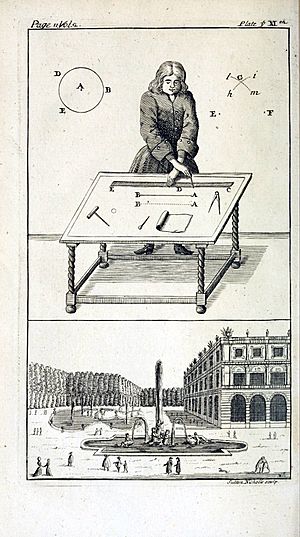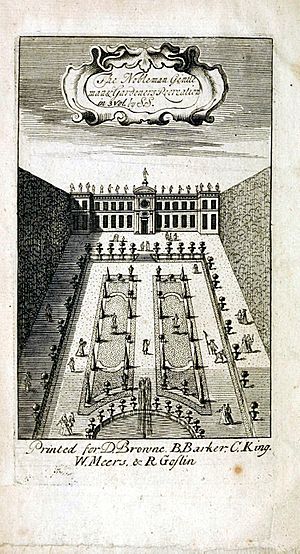Stephen Switzer facts for kids
Stephen Switzer (born 1682, died 1745) was an English gardener and garden designer. He also wrote many books about gardens. Many people believe he was one of the first to promote the "English landscape garden" style. This style looked more natural than the very formal gardens popular before.
Switzer was known for his ideas about how a large, fancy garden could blend into the natural countryside, especially forests. He called his garden style the "Natural and Rural way of Gardens." One modern expert called it the "English Forest Style." This style turned areas like Wray Wood at Castle Howard into winding paths through a forest, almost like a maze.
His most famous book was Ichnographica Rustica (published between 1715 and 1718). This book came out before many new trees and bushes from America arrived in England. These new plants later helped create the "shrubbery" (areas with many shrubs) and "woodland gardens." Switzer's ideas for areas far from the main house stayed more like natural woodlands than planned gardens.
Switzer never traveled abroad to see gardens in other countries. However, he admired the grand, formal gardens of France. He liked their wide views and long paths through trees. He believed that the state of gardening showed how healthy a country's culture was. He thought grand designs, like Blenheim Palace, showed the "greatness of mind" of English noble families.
His ideas about garden design were similar to those of writers like Alexander Pope and Joseph Addison. They also wrote about "natural" gardening. But Switzer's ideas were still a bit formal compared to later garden styles. His book Ichnographica shows very formal gardens with tall, straight hedges. This is different from his writings, which has "puzzled historians for many years." It might have been a misunderstanding with the artist, or he might have changed his mind.
Stephen Switzer's Life and Work
Stephen Switzer started his training in Hampshire, England. He became a garden boy at a plant nursery in Kensington, London. This nursery was run by famous gardeners George London and Henry Wise.
Switzer worked his way up in this large nursery and landscaping business. He helped London and Wise create gardens at several important places. These included Castle Howard in Yorkshire (starting in 1706), especially the "wilderness" area. He also worked at Cirencester Park in Gloucestershire (around 1713) and Blenheim Palace in Oxfordshire. Switzer also designed the garden at Grimsthorpe Castle in Lincolnshire around 1716. He is also known for designing the landscape at Leeswood Hall in Flintshire for Sir George Wynne in the 1720s.
In 1715, Switzer published a book called The Nobleman, Gentleman, and Gardener's Recreation. This book was about "Forest, or Rural Gardening." He later made this book bigger, calling it Ichnographia (1718). He revised it again in 1741–42, adding two more essays, and called it Ichnographia Rustica. He also wrote other books, like The Practical Husbandman and Planter (1733) and An Introduction to a General System of Hydrostaticks and Hydraulicks (1729).
His book Ichnographia was likely written for people who owned small country homes near London. He understood that busy people often needed to "retreat, and breathe the sweet and fragrant Air of gardens." Many of these homes were on gentle hills. He suggested that "all the adjacent Country be laid open to view." This meant showing the "extensive charms of Nature" and the "pleasant County" around the garden. This was still possible at that time.
Switzer saw a difference between city gardens and country gardens. He thought there was no point in growing flowers in country gardens after May. He felt that "the nobler Diversions of the Country take place" then. He meant that other country activities became more important. He was always thinking about the cost of gardening. He was against walled gardens, except for growing some fruit in a kitchen garden. He also disliked most fancy landscaping, topiary (shaping plants into "monstrous shapes of Screws, Monkeys, Giants etc."), and expensive foreign plants.
In his book The Nobleman, Gentleman, and Gardener's Recreation, Switzer included the first long history of gardening in England. He strongly criticized topiary and the formal style of the "Dutch Garden." He also introduced the term ferme ornée. This meant an "ornamental farm." It combined useful farming and animal care with beautiful, natural-looking views.
Switzer had a main rival in creating "naturalistic" garden designs. This was Charles Bridgeman, another gardener trained by London and Wise. Bridgeman was from Cambridgeshire. Switzer often made fun of "several Northern Lads" who thought they knew more about gardening quickly. It is not known if he was talking about Capability Brown (1716–1783), who was from Northumberland.
Stephen Switzer's Books
- 1715-18: Ichnographica Rustica, or The Nobleman, Gentleman, and Gardener's recreation.
- 1724: The Practical Fruit Gardener.
- 1727: The Practical Kitchen Gardener.
- 1729: Introduction to Hydrostatics and Hydraulics.
- 1733–1734: The Practical Husband and Planter.



